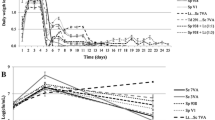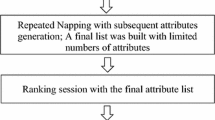Abstract
The usage of alternative non-Saccharomyces yeasts might provide desirable characteristics to white and red sparkling wines. In this study, second fermentation in the bottle was carried out by Saccharomyces cerevisiae as control and two non-Saccharomyces species: Saccharomycodes ludwigii and Schizosaccharomyces pombe. The second fermentations of white base wine made from Vitis Vinifera cv. Airén grapes and red base wine made from Vitis Vinifera cv. Tempranillo grapes, in the bottle were followed by aging on lees during 4 months at 12 °C. Finally, physicochemical properties were analyzed and a sensory evaluation was held. Significant differences were detected among sparkling wines produced with the studied yeasts in acidity parameters and non-volatile compounds. The pyranoanthocyanin content and color intensity was higher with the use of Schizosaccharomyces pombe in red sparkling wines. The total amount of volatile compounds was similar among treatments, but in certain compounds, individual variations in concentration were seen. Total amount of biogenic amines decreased in all the samples after the treatment. Differences were also detected in sensory evaluation; the sparkling wines produced with Saccharomyces cerevisiae showed different aromatic profile in comparison to sparkling wines produced with Schizosaccharomyces pombe, considering the parameters of limpidity, aroma intensity, aroma quality, flowery, fruity, buttery and reduction aromas in white samples; color intensity, limpidity, aroma intensity, herbal, buttery, yeasty, and oxidation aromas in red samples. Usage of non-Saccharomyces yeasts for sparkling wine production with traditional method can be furtherly studied to change specific characteristics of sparkling wines without decreasing their overall quality and obtain differentiation.


Similar content being viewed by others
References
Ribéreau-Gayon P, Dubourdieu D, Donèche B, Lonvaud A (2006) 14. Other winemaking methods. Anonymous handbook of enology, the microbiology of wine and vinifications, 2nd edn. Wiley, Hoboken, pp 458–463
Suárez-Lepe JA, Iñigo Leal B (2004) Microbiología Enológica, Fundamentos de Vinificación, 4th edn. Mundi-Prensa, p 634
Jackson RS (2008) 7. Fermentation: prefermentation practices and biochemistry of alcoholic fermentation.Anonymous wine science: principles and applications. Academic Press, Cambridge, pp 348–374
Estela-Escalante W, Rychtera M, Melzoch K, Hatta-Sakoda B, Ludeña-Cervantes Z, Sarmiento-Casavilca V, Chaquilla-Quilca G (2011) Tip Rev Espec Cienc Quím Biol, 14:12–23
Romano P, Marchese R, Laurita C, Saleano G, Turbanti L (1999) World J Microb Biot 15:451–454
Domizio P, Romani C, Lencioni L, Comitini F, Gobbi M, Mannazzu I, Ciani M (2011) Int J Food Microbiol 147:170–180
Benito S, Palomero F, Calderón F, Palmero D, Suárez-Lépe J (2014) Food Microbiol 42:218–224
Benito S, Palomero F, Calderón F, Palmero D, Suárez-Lepe JA (2014) Schizosaccharomyces. In: Batt CA, Tortorello ML (eds) Encylopedia of food microbiology, 2nd edn. Elsevier, Amsterdam, pp 365–370
Palomero F, Morata A, Benito S, Calderón F, Suárez-Lepe J (2009) Food Chem 112:432–441
Benito S, Palomero F, Morata A, Calderón F, Suárez-Lepe JA (2012) Int J Food Sci Tech 47:2101–2108
Uthurry C, Varela F, Colomo B, Lepe JS, Lombardero J, Del Hierro JG (2004) Food Chem 88:329–336
Morata A, Gómez-Cordovés M, Colomo B, Suárez J (2003) J Agric Food Chem 51:7402–7409
Kulkarni P, Loira I, Morata A, Tesfaye W, González MC, Suárez-Lepe JA (2015) LWT Food sci Technol 64:1255–1262
Liu L, Loira I, Morata A, Suárez-Lepe J, González M, Rauhut D (2016) Eur Food Res Technol 242:559–569
Morata A, González C, Suárez-Lepe JA (2007) Int J Food Microbiol 116:144–152
Glories Y (1984) Conn Vigne et Vin 18:195–217
Glories Y (1984) Conn Vigne et Vin 18:253–271
Romano P, Fiore C, Paraggio M, Caruso M, Capece A (2003) Int J Food Microbiol 86:169–180
Lambrechts M, Pretorius I (2000) S Afr J Enol Vitic 21:97–129
Anonymous, OIV (2016) International Code of Oenological Practices, 2016 Issue. http://www.oiv.int/public/medias/2696/code-2016-en.pdf
Vasserot Y, Caillet S, Maujean A (1997) Am J Enol Vitic 48:433–437
Morata A, Benito S, Loira I, Palomero F, González M, Suarez-Lepe J (2012) Int J Food Microbiol 159:47–53
Suárez-Lepe J, Morata A (2012) Trends Food Sci Technol 23:39–50
Benito S, Palomero F, Gálvez L, Morata A, Calderón F, Palmero D, Suárez-Lepe JA (2014) Food Technol Biotech 52:376–382
Anonymous, OIV (2011) Maximum acceptable limits of various substances contained in wine, 2011 Issue. http://www.oiv.int/js/lib/pdfjs/web/viewer.html?file=/public/medias/2601/oiv-ma-c1-01.pdf
Rapp A, Mandery H (1986) Experientia 42:873–884
Moreno-Arribas MV, Polo MC (2009) Chap. 6A. Amino acids and biogenic amines. In: Moreno-Arribas V, Polo MC (eds) Wine chemistry and biochemistry. Springer, Berlin, pp 162–189
Benito S, Hofmann T, Laier M, Lochbühler B, Schüttler A, Ebert K, Fritsch S, Röcker J, Rauhut D (2015) Eur Food Res Technol 241:707–717
Fraile P, Garrido J, Ancín C (2000) J Agric Food Chem 48:1789–1798
Hernández-Orte P, Ibarz M, Cacho J, Ferreira V (2005) Food Chem 89:163–174
Lehtonen P (1996) Am J Enol Vitic 47:127–133
Alcaide-Hidalgo JM, Moreno-Arribas MV, Martín-Álvarez PJ, Polo MC (2007) Food Chem 103:572–581
Sumby KM, Grbin PR, Jiranek V (2014) Appl Microbiol Biotechnol 98:8111–8132
Benito Á, Calderón F, Palomero F, Benito S (2015) Molecules 20:9510–9523
Anlı RE, Bayram M (2008) Food Rev Int 25:86–102
Romano P, Capece A, Poeta C (2007) Bulletin de l’OIV, pp 80–91
Martuscelli M, Arfelli G, Manetta A, Suzzi G (2013) Food Chem 140:590–597
Granchi L, Romano P, Mangani S, Guerrini S, Vincenzini M (2005) Bull l’OIV Off Int Vigne Vin 78:595–610
Medina K, Boido E, Fariña L, Gioia O, Gomez M, Barquet M, Gaggero C, Dellacassa E, Carrau F (2013) Food Chem 141:2513–2521
Marcobal Á, Martín-Álvarez PJ, Polo MC, Muñoz R, Moreno-Arribas M (2006) J Food Protect 69:397–404
Acknowledgements
This work was funded by Spain’s Ministry of Economy and Competitiveness (AGL2013-40503-R and AGL2013-47706-R). The authors would like to thank J. A. Sánchez (Department of Chemistry and Food Technology) for their excellent technical assistance. The authors are also grateful to the accredited Estación Enológica de Haro laboratory, where the biogenic amines and amino acids analysis were performed, especially to Montserrat Iñiguez and Elena Melendez.
Author information
Authors and Affiliations
Corresponding author
Ethics declarations
Conflict of interest
The authors declare that they have no conflicts of interest.
Research involving human participants and/or animals
This article does not contain any studies with human or animal subjects.
Rights and permissions
About this article
Cite this article
Ivit, N.N., Loira, I., Morata, A. et al. Making natural sparkling wines with non-Saccharomyces yeasts. Eur Food Res Technol 244, 925–935 (2018). https://doi.org/10.1007/s00217-017-3015-y
Received:
Revised:
Accepted:
Published:
Issue Date:
DOI: https://doi.org/10.1007/s00217-017-3015-y




